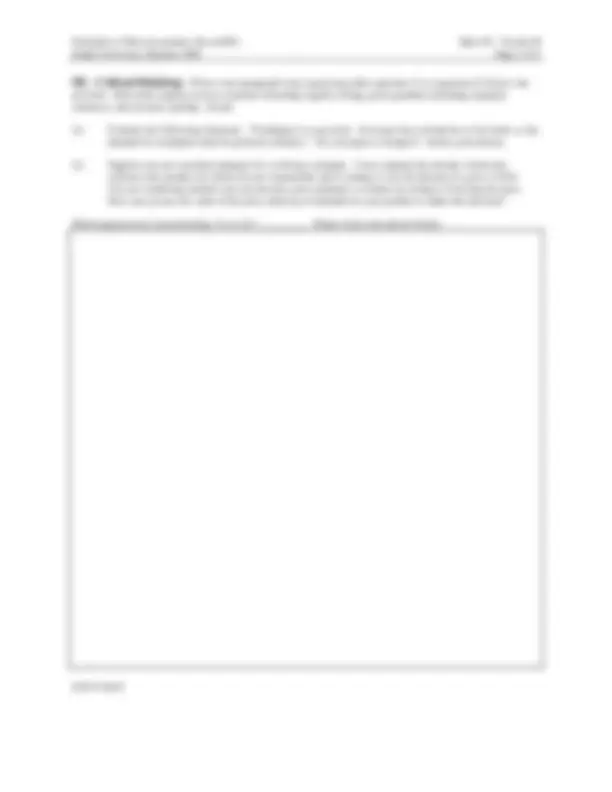



Study with the several resources on Docsity

Earn points by helping other students or get them with a premium plan


Prepare for your exams
Study with the several resources on Docsity

Earn points to download
Earn points by helping other students or get them with a premium plan
Community
Ask the community for help and clear up your study doubts
Discover the best universities in your country according to Docsity users
Free resources
Download our free guides on studying techniques, anxiety management strategies, and thesis advice from Docsity tutors
Material Type: Quiz; Professor: Boal; Class: PRINCIPLES OF MICROECONOMICS; Subject: Economics; University: Drake University; Term: Summer 2001;
Typology: Quizzes
1 / 3

This page cannot be seen from the preview
Don't miss anything!


Principles of Microeconomics Signature: (Econ 002) Printed name: Drake University, Summer 2001 William M. Boal ID number:
INSTRUCTIONS: This quiz is closed-book, closed-notes, but calculators are permitted. Numerical answers, if rounded, must be correct to at least 3 significant digits. Point values for each question are noted in brackets. Maximum total points are 100.
(1) The supply curve in the graph below is
a. perfectly elastic. b. perfectly inelastic. c. unitary elastic. d. Cannot be determined from information given.
(2) Suppose the price elasticity of demand for internet service is -3. If the price of internet service is falls, the revenue received by internet service providers will a. decrease. b. remain constant. c. increase. d. fluctuate randomly.
(3) If buyers or consumers have more time to anticipate and adjust to a price change, their demand is a. more elastic. b. less elastic. c. downward-sloping. d. Time for adjustment does not affect elasticity.
(4) Which good is likely to have the most elastic demand? a. Libby’s brand tomato juice. b. All tomato juice. c. All juice. d. Demand for all three must have the same elasticity.
scratch workonly the answers in the boxes will be graded. Work carefullypartial credit is not normally given for questions in this section.
(1) [12 pts] Suppose that when the price of corn is $0.50 per pound, 300 pounds are sold per week; but when the price is $1.10 per pound, 180 pounds are sold per month. a. Compute the price elasticity of demand using the so-called arc formula.
b. Suppose potatoes were measured in kilograms rather than pounds. Would the elasticity increase, decrease, or remain the same? c. Suppose the price of potatoes were measured in cents rather than dollars. Would the elasticity increase, decrease, or remain the same?
Supply
Principles of Microeconomics (Econ 002) Drake University, Summer 2001
Quiz #3: Version B Page 2 of 3
(2) [16 pts] Use the information given below to determine whether each pair of goods (in italics ) consists of substitutes or complements. Also compute the cross-price elasticity of demand. [Hint: The sign matters!] Substitutes or complements?
Computed cross-price elasticity a. The price of computers fall s by 25%, causing the quantity of monitors sold to increase by 10%. b. The price of hamburgers rises by 10%, causing the quantity of hot dogs consumed to increase by 3%.
(3) [16 pts] Use the information given below to determine whether the good (in italics ) is a normal good or an inferior good. Also compute the income elasticity of demand. [Hint: The sign matters!] Normal good or inferior good?
Computed income elasticity a. A boom raises personal income by 4%, causing the number of digital cameras sold to increase by 8%. b. A recession causes consumer’s income to fall by 2%, causing sales of macaroni-and-cheese dinners to increase by 1%.
(4) [16 pts] Suppose the government wants to increase the number of public school teachers by 15%. Also suppose the elasticity of supply of teachers is known to be 3.. a. To increase the number of teachers by this much, must pay levels for teachers increase or decrease? b. ... by how much?
c. Will the total size of the teacher payroll (the amount budgeted to pay teachers) increase or decrease? d. ... by approximately how much?
(5) [16 pts] Suppose the cable company raises cable rates by 5%. The elasticity of demand for cable TV service is known to be -0.6. Assume everything else affecting demand for cable service remains constant. a. Will the number of cable subscribers increase or decrease?
c. Will revenue received by the cable company increase or decrease?
d. ... by approximately how much?